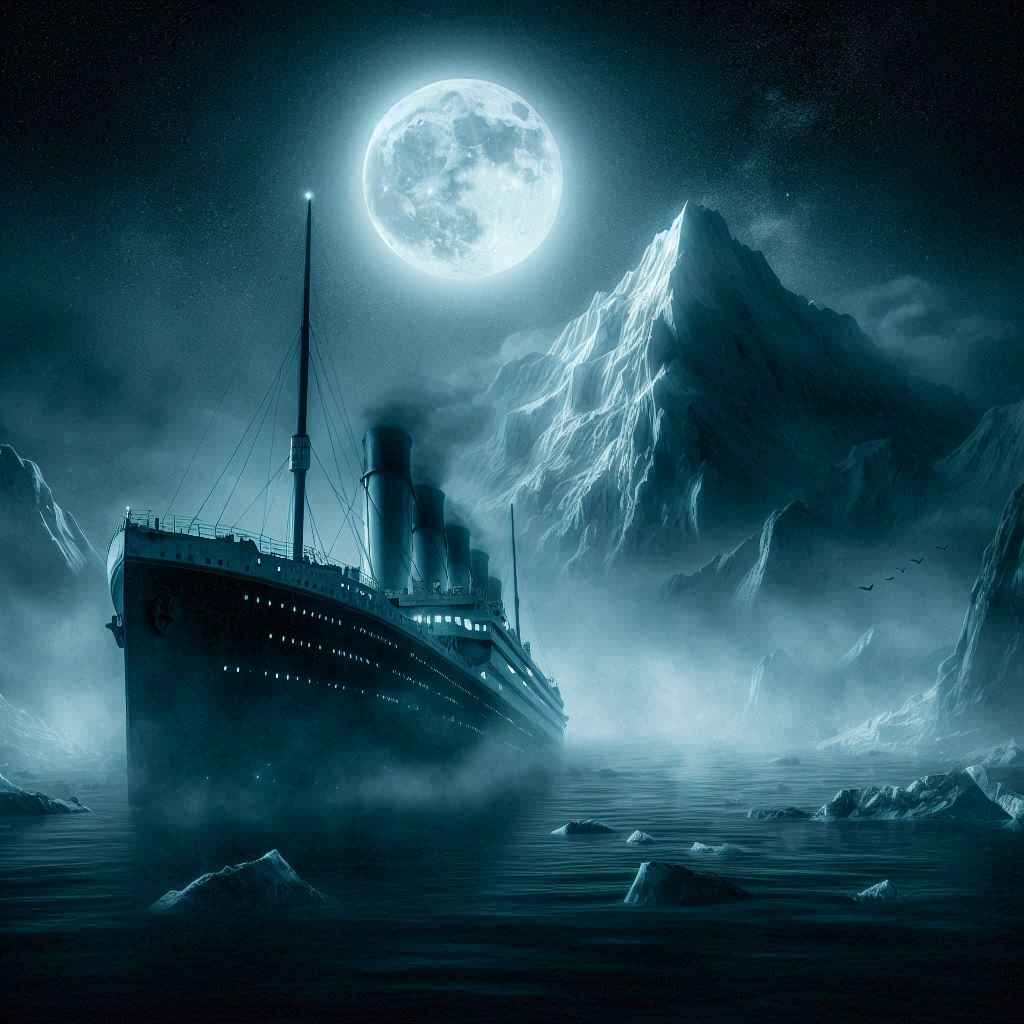The Convergence of the Twain
Thomas Hardy
1840 to 1928

(Lines on the loss of the "Titanic")
In a solitude of the sea
Deep from human vanity,
And the Pride of Life that planned her, stilly couches she.
Steel chambers, late the pyres
Of her salamandrine fires,
Cold currents thrid, and turn to rhythmic tidal lyres.
Over the mirrors meant
To glass the opulent
The sea-worm crawls — grotesque, slimed, dumb, indifferent.
Jewels in joy designed
To ravish the sensuous mind
Lie lightless, all their sparkles bleared and black and blind.
Dim moon-eyed fishes near
Gaze at the gilded gear
And query: "What does this vaingloriousness down here?"…
Well: while was fashioning
This creature of cleaving wing,
The Immanent Will that stirs and urges everything
Prepared a sinister mate
For her — so gaily great —
A Shape of Ice, for the time far and dissociate.
And as the smart ship grew
In stature, grace, and hue,
In shadowy silent distance grew the Iceberg too.
Alien they seemed to be;
No mortal eye could see
The intimate welding of their later history,
Or sign that they were bent
By paths coincident
On being anon twin halves of one august event,
Till the Spinner of the Years
Said "Now!" And each one hears,
And consummation comes, and jars two hemispheres.
Thomas Hardy's The Convergence of the Twain
Introduction
Thomas Hardy's "The Convergence of the Twain" stands as a poignant reflection on the tragic sinking of the RMS Titanic, an event that shook the world in 1912. This poem, composed shortly after the disaster, offers a profound meditation on the interplay between human ambition and the inexorable forces of fate. Through a masterful use of imagery, symbolism, and structural elements, Hardy crafts a narrative that transcends the immediate tragedy to explore deeper themes of hubris, destiny, and the indifference of the natural world to human endeavors.
Historical Context and Thematic Overview
To fully appreciate the depth of Hardy's work, one must first consider the historical context in which it was written. The sinking of the Titanic represented more than just a maritime disaster; it was a symbolic blow to the ethos of progress and technological infallibility that characterized the early 20th century. Hardy, known for his pessimistic outlook on human affairs, seizes upon this event to craft a poem that serves as both elegy and cautionary tale.
The poem's structure, divided into eleven tercet stanzas, mirrors the methodical, almost fatalistic progression of events leading to the ship's demise. Each stanza builds upon the last, creating a sense of inexorable movement towards a predestined conclusion. This structural choice reinforces one of the poem's central themes: the idea that the Titanic's fate was sealed long before its maiden voyage.
Imagery and Symbolism
Hardy's use of imagery is particularly striking in its juxtaposition of the ship's opulence with the cold, indifferent sea that now serves as its tomb. In the opening stanzas, we are presented with vivid descriptions of the Titanic's remains:
"Steel chambers, late the pyres Of her salamandrine fires, Cold currents thrid, and turn to rhythmic tidal lyres."
The transformation of the ship's once-fiery engines into "rhythmic tidal lyres" serves as a haunting reminder of the transience of human achievement in the face of natural forces. The imagery of sea-worms crawling over mirrors "meant to glass the opulent" further underscores this theme, presenting a grotesque inversion of the luxury that once defined the vessel.
Hardy's symbolism extends beyond mere descriptions of the wreck. The "Jewels in joy designed / To ravish the sensuous mind" now lie "lightless, all their sparkles bleared and black and blind." This powerful imagery not only evokes the physical reality of the sunken ship but also serves as a metaphor for the dimming of human aspirations and the futility of material excess in the face of mortality.
The Role of Fate and the "Immanent Will"
Central to the poem's thematic structure is the concept of the "Immanent Will," a force that Hardy presents as orchestrating the events leading to the Titanic's demise. This notion reflects Hardy's complex philosophical views, which often grappled with questions of determinism and the role of chance in human affairs.
The poem personifies this force, describing how it "Prepared a sinister mate" for the Titanic in the form of an iceberg. The use of the word "mate" is particularly significant, suggesting a kind of cosmic marriage between ship and ice, fated to come together in a moment of "consummation" that "jars two hemispheres."
This portrayal of fate as an active, almost sentient force adds a layer of inevitability to the narrative. The ship and iceberg are described as "twin halves of one august event," their convergence predestined by forces beyond human comprehension or control. This fatalistic view serves to underscore the limitations of human agency and the ultimate insignificance of human achievements in the grand scheme of the universe.
Critique of Human Vanity
Throughout the poem, Hardy maintains a critical stance towards human pride and ambition. The Titanic is described as a product of "human vanity" and "the Pride of Life," phrases that cast its creation in a decidedly negative light. The sea creatures that now inhabit the wreck are described as questioning the "vaingloriousness" of the human artifacts they encounter, further emphasizing the futility of human pretensions to grandeur.
This critique extends beyond the specific case of the Titanic to encompass broader themes of human hubris in the face of nature's power. The poem serves as a reminder that, for all our technological achievements and material excess, humanity remains subject to forces far greater than ourselves.
Structural and Linguistic Analysis
The poem's form and language deserve close attention. The use of tercets, with their AAA rhyme scheme, creates a sense of inexorable progression, each stanza building upon the last like waves upon the ocean. The language is rich with alliteration and internal rhyme, as in lines like "Cold currents thrid, and turn to rhythmic tidal lyres," which create a haunting musicality that echoes the poem's themes.
Hardy's diction is carefully chosen to reinforce the poem's themes. Words like "solitude," "vanity," "pride," and "vaingloriousness" create a semantic field that underscores the critique of human ambition. Meanwhile, the use of nautical and geological terminology ("thrid," "salamandrine," "dissociate") lends the poem a sense of scientific precision that contrasts with its more philosophical musings.
The Convergence as Metaphor
The titular "convergence" serves as a powerful metaphor on multiple levels. On the surface, it refers to the physical collision between ship and iceberg. However, it also represents the meeting point between human ambition and natural limitation, between the hubristic belief in technological invincibility and the harsh reality of our vulnerability.
Furthermore, the convergence can be read as a metaphor for the intersection of different timeframes: the brief span of human history against the vast expanse of geological time. The iceberg, described as "far and dissociate" from the ship, represents forces that have been in motion long before human civilization and will continue long after.
Conclusion
"The Convergence of the Twain" stands as a masterpiece of early 20th-century poetry, offering a complex and nuanced reflection on one of the era's defining tragedies. Through his skillful use of imagery, symbolism, and structure, Hardy transforms the Titanic disaster into a meditation on the human condition itself.
The poem's enduring power lies in its ability to transcend the specific historical event it describes, speaking to universal themes of fate, hubris, and the place of humanity in an indifferent universe. As we continue to grapple with the consequences of our technological ambitions and our relationship with the natural world, Hardy's words remain as relevant and thought-provoking as ever.
In the final analysis, "The Convergence of the Twain" serves not just as an elegy for the Titanic and its passengers, but as a somber reminder of the limits of human achievement and the ultimate futility of pride in the face of cosmic forces. It challenges us to consider our place in the universe and the true value of our endeavors, inviting reflection on what, if anything, can truly withstand the inexorable passage of time and the vagaries of fate.
This text was generated by AI and is for reference only. Learn more
Want to join the discussion? Reopen or create a unique username to comment. No personal details required!



Comments
No comments yet. Be the first to comment!